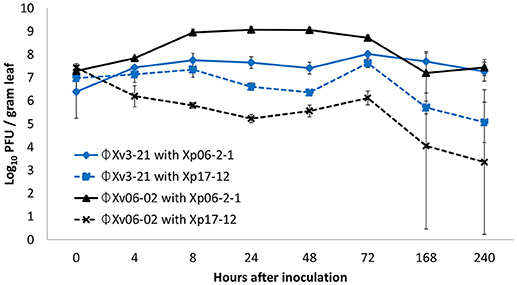- 1Plant Pathology Department, University of Florida, Gainesville, FL, United States
- 2Department of Plant Protection, Can Tho University, Can Tho, Vietnam
by Balogh, B., Nga, N. T. T., and Jones, J. B. (2018) Front. Microbiol. 9:2176. doi: 10.3389/fmicb.2018.02176
In the original article, there was a mistake in Figure 1 as published. The author and the Frontiers Production Office published Figure 2 as Figure 1 in error. The missing Figure 1 appears below.

Figure 1. Populations of phages ΦXv3-21 and ΦXp06-02 in the tomato phyllosphere in the presence of Xanthomonas perforans strains Xp06-21 or Xp17-12.
In addition, there was an error in the affiliations for author BB. Nichino Europe, Co., Ltd., Cambridge, United Kingdom is the author's current affiliation and not the one held at the time this research was conducted. Therefore, the affiliation list has been updated to reflect this and Nichino Europe added as the present address.
The authors and the Frontiers Production Office apologize for these errors and state that they do not change the scientific conclusions of the article in any way. The original article has been updated.
Conflict of Interest Statement
The authors declare that the research was conducted in the absence of any commercial or financial relationships that could be construed as a potential conflict of interest.
Keywords: bacterial spot of tomato, Xanthomonas perforans, Xanthomonas citri, citrus canker, biological control
Citation: Balogh B, Nga NTT and Jones JB (2018) Corrigendum: Relative Level of Bacteriophage Multiplication in vitro or in Phyllosphere May Not Predict in planta Efficacy for Controlling Bacterial Leaf Spot on Tomato Caused by Xanthomonas perforans. Front. Microbiol. 9:2647. doi: 10.3389/fmicb.2018.02647
Received: 02 October 2018; Accepted: 17 October 2018;
Published: 29 October 2018.
Approved by:
Frontiers in Microbiology Editorial Office, Frontiers Media SA, SwitzerlandCopyright © 2018 Balogh, Nga and Jones. This is an open-access article distributed under the terms of the Creative Commons Attribution License (CC BY). The use, distribution or reproduction in other forums is permitted, provided the original author(s) and the copyright owner(s) are credited and that the original publication in this journal is cited, in accordance with accepted academic practice. No use, distribution or reproduction is permitted which does not comply with these terms.
*Correspondence: Jeffrey B. Jones, amJqb25lc0B1ZmwuZWR1
† Present Address: Botond Balogh, Nichino Europe, Co., Ltd., Cambridge, United Kingdom
 Botond Balogh
Botond Balogh Nguyen Thi Thu Nga
Nguyen Thi Thu Nga Jeffrey B. Jones
Jeffrey B. Jones